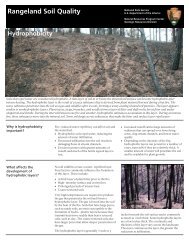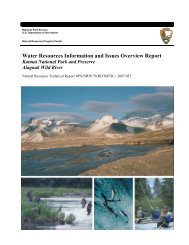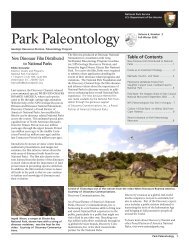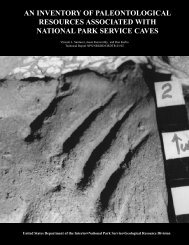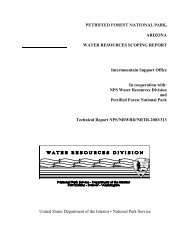Naphthalene, C1 - National Park Service
Naphthalene, C1 - National Park Service
Naphthalene, C1 - National Park Service
Create successful ePaper yourself
Turn your PDF publications into a flip-book with our unique Google optimized e-Paper software.
Kinlin TE et al; J Agric Food Chem 20:<br />
1021 (1972) (3) Takeoka GR et al; J Agric<br />
Food Chem 36: 553-60 (1988) (4) Lovegren<br />
NV et al; J Agric Food Chem 27: 851-3<br />
(1978)].<br />
Non-alcoholic beverages: 1.0 Ppm; ice<br />
creams, ices: 1.0 Ppm; candy: 1.0 Ppm;<br />
gelatins & puddings: 1.0 Ppm.<br />
[Fenaroli's Handbook of Flavor<br />
Ingredients. Volume 2. Edited,<br />
translated, and revised by T.E. Furia and<br />
N. Bellanca. 2nd ed. Cleveland: The<br />
Chemical Rubber Co., 1975. 385].<br />
B) Concentrations or Doses of Concern in Food Items<br />
Eaten by Humans (Includes Allowable Tolerances in Human<br />
Food, FDA, State and Standards of Other Countries):<br />
No information found. Compare total naphthalenes<br />
to naphthalene concentrations (see naphthalene<br />
entry).<br />
C) Body Burden Residues in Humans: Typical, Elevated, or<br />
of Concern Related to the Well-being of Humans:<br />
No information found. Compare total naphthalenes<br />
to naphthalene concentrations (see naphthalene<br />
entry).<br />
Tis.Misc. (Other Tissue Information):<br />
<strong>Naphthalene</strong> was predicted not to be phototoxic using QSAR<br />
estimates [891]. Alkyl PAHs often (there may be<br />
exceptions) tend to be equally phototoxic to the parent<br />
compound PAH (see "PAHs as a group" entry).<br />
Bio.Detail: Detailed Information on Bioconcentration,<br />
Biomagnification, or Bioavailability:<br />
Alkyl PAHs tend to bioaccumulate to a greater degree than<br />
parent compound PAHs [347,885]. Introduction or extension of an<br />
alkyl group increases lipophilicity, which often appears as<br />
increased absorption [856].<br />
Alkyl naphthalenes tend to persist longer in amphipod tissues<br />
[885] and to bioaccumulate faster in tissues [851] than<br />
naphthalene. Bioconcentration of naphthalenes by amphipods was<br />
greatest (about 1000 times) in flow through systems. In the<br />
sediment exposure system, no naphthalene was present in amphipod<br />
tissues after four days and by the 18th day only dimethyl<br />
naphthalenes were present [885].<br />
Log Kow values for alkyl naphthalenes [971]:





